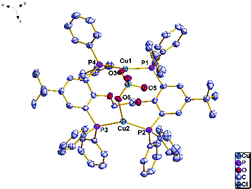Novel self-adaptive boat-shaped complexes with a tetraphosphine ligand†
Abstract
A series of novel boat-shaped host–guest complexes were designed and synthesized by the combination of a new calixarene fragment-based tetraphosphine ligand L with group 11 metal salts Cu(MeCN)4ClO4 and AgNO3 in a self-assembly process, and by the following anion exchange reactions of complex 1 with sodium p-toluenesulfonate, AcONa, PhCO2Na and sodium 9-anthrylcarboxylate. The host with a novel boat-shaped cavity is capable of self-adaptive encapsulation of various anions of different sizes through M(I)–O coordinations and CH⋯π interactions between the host and guest anion. The DFT calculations confirmed that the CH⋯π interaction played a vital role in the self-adaptive phenomenon in complexes 4–6.



 Please wait while we load your content...
Please wait while we load your content...